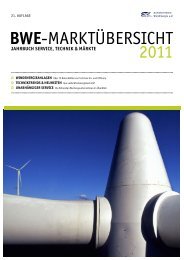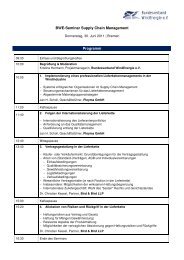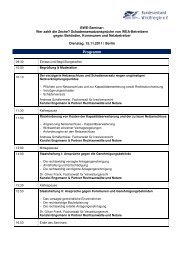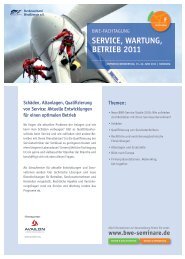2011 WIND INDUSTRY in gERMany - Wind-Energy-Market
2011 WIND INDUSTRY in gERMany - Wind-Energy-Market
2011 WIND INDUSTRY in gERMany - Wind-Energy-Market
You also want an ePaper? Increase the reach of your titles
YUMPU automatically turns print PDFs into web optimized ePapers that Google loves.
Economic reportTechnology – turb<strong>in</strong>es get biggerthanks to high-techW<strong>in</strong>d turb<strong>in</strong>es have cont<strong>in</strong>ued to grow <strong>in</strong> size over the past few years. On average,turb<strong>in</strong>es that were erected <strong>in</strong> Germany <strong>in</strong> 2010 had a rated capacity of just over 2 MW.Accord<strong>in</strong>g to the German W<strong>in</strong>d <strong>Energy</strong> Institute (DEWI), half of the w<strong>in</strong>d turb<strong>in</strong>es<strong>in</strong>stalled <strong>in</strong> Germany fell <strong>in</strong>to the 2 MW class and a further third <strong>in</strong>to the 3 MW class. Thisprogress is enabled and supported by cont<strong>in</strong>uous <strong>in</strong>novation <strong>in</strong> design, construction,components and ma<strong>in</strong>tenance concepts.It takes a modern turb<strong>in</strong>e less than amonth to feed <strong>in</strong>to the grid the power thatcould be generated <strong>in</strong> an entire year by aturb<strong>in</strong>e <strong>in</strong>stalled <strong>in</strong> 1995. Back then, turb<strong>in</strong>escould achieve a rated capacity of600 kW and a rotor diameter of 46 metres.Today’s top-class turb<strong>in</strong>es now achieve arated capacity of 7.5 MW with a rotor diameterof 127 metres and a total height ofnearly 200 metres. That is enough to supplyaround 6,000 households with power.Meanwhile, the <strong>in</strong>dustry is prepar<strong>in</strong>g forthe next class of modern turb<strong>in</strong>es. Somemanufacturers are already design<strong>in</strong>g 10 MWturb<strong>in</strong>es and scientists are speculat<strong>in</strong>gabout 20 MW turb<strong>in</strong>es.For years, w<strong>in</strong>d turb<strong>in</strong>es have achieved anearly constant availability of 98 %. Toensure that this high standard is ma<strong>in</strong>ta<strong>in</strong>ed,the majority of modern turb<strong>in</strong>eshave condition monitor<strong>in</strong>g systems. Here,sensors monitor components <strong>in</strong> the drivetra<strong>in</strong> to diagnose faults before damage iscaused to the turb<strong>in</strong>e. They are connectedto the manufacturer’s or service provider’scentral control computer. Operators canuse this to better plan service operationsand ma<strong>in</strong>tenance logistics. In offshorew<strong>in</strong>d farms, where unexpected faults andfailures at sea cannot be remedied asquickly as on land, monitor<strong>in</strong>g systems arealready standard.In addition, gearless turb<strong>in</strong>es have recentlybeen experienc<strong>in</strong>g a renaissance. In thistype of design, the rotor drives the generatordirectly. This means that there is noneed to convert the slow rotation of therotor <strong>in</strong> light w<strong>in</strong>ds <strong>in</strong>to a faster rotationus<strong>in</strong>g a gearbox. Accord<strong>in</strong>g to <strong>in</strong>formationpublished <strong>in</strong> neue energie magaz<strong>in</strong>e, theworld market share of the capacity<strong>in</strong>stalled <strong>in</strong> 2009 from gearless turb<strong>in</strong>eswas 16 %. This technology is also used <strong>in</strong>the top-class turb<strong>in</strong>es generat<strong>in</strong>g 7.5 MW.The weight of turb<strong>in</strong>es – and therefore thematerial costs – has also reduced considerably<strong>in</strong> relation to performance. As well asthe common steel construction, towers arenow also built <strong>in</strong> a mixed design compris<strong>in</strong>ga concrete base and steel upper part.Lattice towers are also mak<strong>in</strong>g a comebackand can reach heights of up to 160 metres.The rotors too are undergo<strong>in</strong>g cont<strong>in</strong>uousdevelopment. This has allowed noise emissionsto be reduced, for example. And tokeep light disturbance at night to a m<strong>in</strong>imum,the navigation lights for air trafficcan be <strong>in</strong>tegrated <strong>in</strong> the rotor tips.W<strong>in</strong>d <strong>in</strong>dustry <strong>in</strong> Germany21







